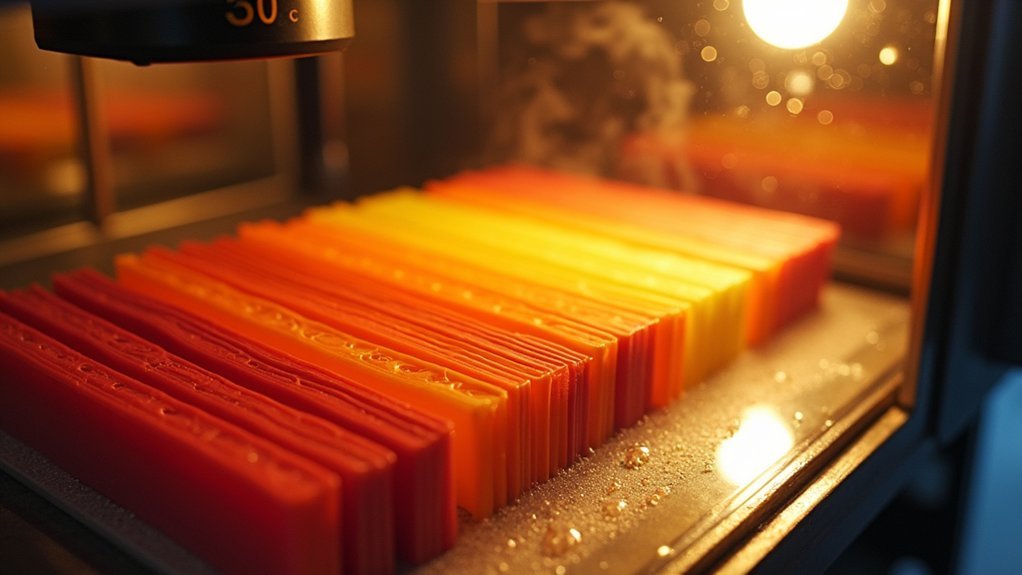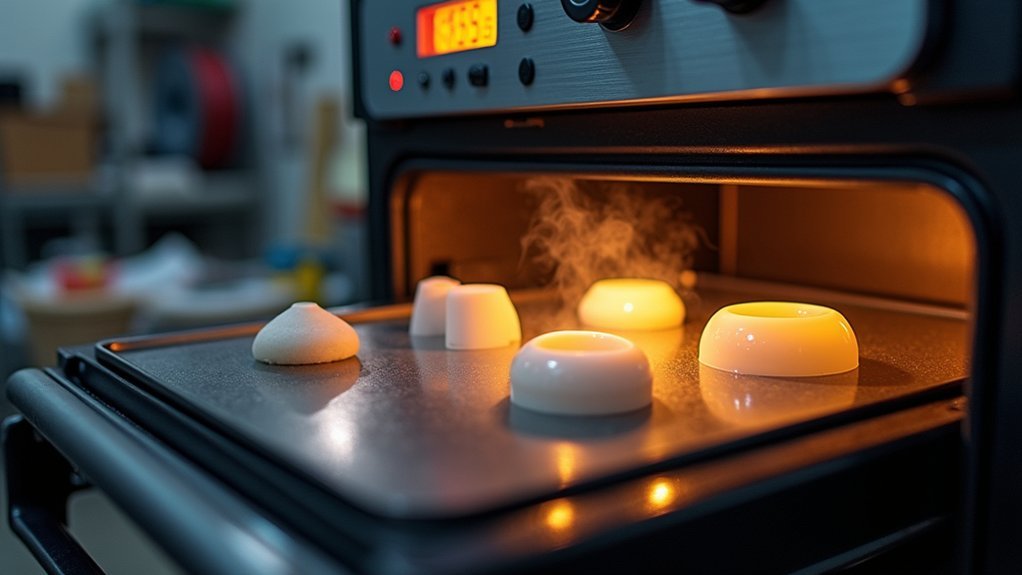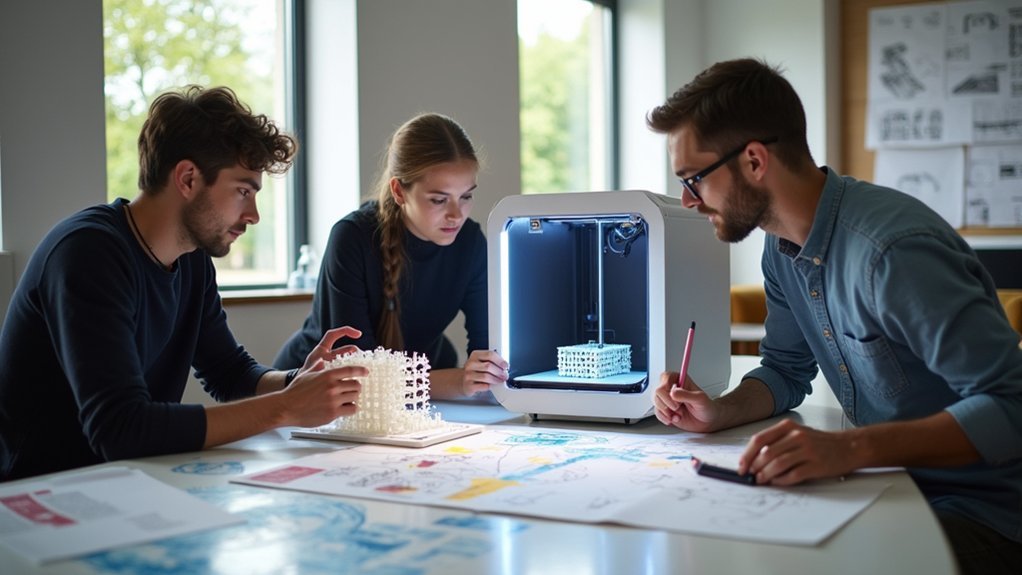You’ll maximize PLA strength by annealing at 90-110°C for 45-60 minutes using precise temperature control. First, print with 100% infill and line patterns, then place parts in preheated oven with sand support to prevent warping. Heat triggers polymer chain reorganization from amorphous to crystalline structure, dramatically increasing strength and heat resistance. Allow gradual cooling inside the turned-off oven to prevent thermal shock and maintain dimensional stability. Follow this guide to master the complete process.
Understanding the Science Behind PLA Annealing

When you heat PLA above its glass transformation temperature of approximately 65°C (149°F), you’re triggering a fundamental molecular transformation that greatly improves the material’s performance.
Heating PLA beyond 65°C triggers crucial molecular reorganization that transforms the material’s mechanical properties and overall performance characteristics.
This heating process allows PLA’s polymer chains to reorganize from their amorphous state into a more structured, crystalline arrangement. The crystallization significantly enhances mechanical properties, transforming brittle material into something with superior strength and impact resistance.
During this molecular rearrangement, annealing helps reduce residual stress that accumulated during the printing process, resulting in better layer adhesion and overall durability.
However, this transformation comes with dimensional changes—your parts will shrink in X and Y dimensions while potentially expanding slightly in the Z direction. Understanding these scientific principles enables you to predict and compensate for these changes in your designs.
Essential Equipment and Materials for the Annealing Process
You’ll need specific equipment to successfully anneal your PLA parts and achieve consistent results.
The process requires precise temperature control, proper support materials to prevent warping, and monitoring tools to track your progress.
Having the right setup guarantees you’ll maintain safe operating conditions while transforming your printed parts effectively.
Oven Temperature Control Requirements
Since precise temperature control determines the success of your PLA annealing process, you’ll need an oven that maintains consistent temperatures between 75-125°C (167-257°F).
Electric hot air ovens excel at meeting these oven temperature control requirements because they distribute heat evenly throughout the chamber, preventing hot spots that could warp your parts.
You’ll want to invest in a reliable digital thermometer or temperature gauge to monitor actual oven temperatures, as built-in dials often prove inaccurate.
Always preheat your oven before inserting PLA parts to establish a stable thermal environment. This preheating step guarantees your parts experience consistent temperatures from the moment they’re placed inside, promoting uniform annealing throughout the material structure and maximizing strength improvements.
Support Materials and Containers
Beyond maintaining proper oven temperatures, selecting the right support materials and containers protects your PLA parts from deformation during the annealing process.
You’ll need a container that provides at least two inches of space around your PLA part to guarantee even heat distribution. Fine sand works exceptionally well as support materials, preventing warping while allowing better heat transfer throughout the annealing cycle.
For direct placement without sand, use a high-temperature baking tray that’s oven-compatible.
Before placing any parts in your container, remove all adhesive residue and support materials from the printed piece. This prevents contamination and guarantees uniform heating.
The right combination of proper containers and support materials creates ideal conditions for successful annealing results.
Safety Equipment and Monitoring
While temperature control forms the foundation of successful annealing, proper safety equipment protects you from the inherent risks of working with heated materials and high-temperature ovens.
You’ll need heat-resistant gloves and safety goggles as essential safety equipment to prevent burns and eye injuries when handling hot PLA parts. An oven thermometer guarantees accurate temperature monitoring within the critical 75-125°C range for effective annealing.
Place your printed parts on a baking sheet to avoid direct contact with heating elements and achieve uniform heating. Use a digital timer to track the 45-60 minute annealing duration precisely.
Prepare a heat-resistant cooling surface where parts can gradually return to room temperature, preventing thermal shock and warping that could compromise your annealing results.
Optimal Print Settings Before Annealing
Before you heat your PLA parts, you’ll need to optimize your print settings to achieve the best annealing results.
Set your infill to 100% using a line pattern to create completely solid parts. This eliminates internal voids that weaken prints and hinder annealing effectiveness. Avoid hexagon, triangle, or grid infill patterns since they leave gaps that compromise structural integrity.
Configure your print temperatures according to your specific filament requirements to guarantee proper layer adhesion.
Consider upgrading to advanced materials like Tough PLA or HTPLA, which are engineered for annealing and deliver superior thermal resistance and impact strength.
Clean your prints thoroughly before annealing by removing all brims and adhesive residues, as contaminants interfere with heat distribution and material property improvements.
Temperature Guidelines for Maximum Strength Enhancement

You’ll achieve maximum strength enhancement by maintaining annealing temperatures between 90°C and 110°C, with 90°C providing the best balance of strength improvement without deformation risk.
Your parts need consistent heat exposure for 45 to 60 minutes to allow proper molecular rearrangement within the PLA structure.
Never exceed 170°C during the process, as this temperature will cause your parts to collapse and lose structural integrity completely.
Optimal Temperature Ranges
When annealing PLA parts, you’ll achieve maximum strength enhancement by maintaining temperatures between 90°C (194°F) and 110°C (230°F).
These ideal temperature ranges provide the perfect balance for molecular rearrangement without compromising your part’s integrity.
You’ll find that 90°C delivers excellent results, greatly boosting tensile strength while enhancing heat resistance.
This temperature guarantees consistent outcomes with minimal risk of deformation.
Avoid exceeding 110°C, as higher temperatures can cause dimensional changes and warping that’ll compromise your part’s accuracy.
You’ll need careful monitoring throughout the process to maintain steady temperatures.
Hold your target temperature for 45 to 60 minutes to allow complete molecular restructuring.
This duration transforms PLA’s glass transformation temperature from 55°C to approximately 85°C, considerably improving overall durability and performance characteristics.
Heat Duration Timing
Temperature control means little without proper timing to maximize your PLA part’s strength gains. Your heat duration timing should target 45 to 60 minutes at your selected annealing temperature.
This timeframe guarantees uniform heat distribution throughout the part’s entire structure, allowing polymer chains to reorganize effectively for enhanced mechanical properties.
Don’t rush the process by reducing heating time, as insufficient duration won’t achieve ideal strengthening. Conversely, extending beyond 60 minutes doesn’t provide additional benefits and may increase warping risks.
Monitor your parts closely during this window to confirm they’re maintaining their shape while gaining strength. The key is consistency—maintain your target temperature throughout the entire duration for maximum effectiveness.
Step-by-Step Annealing Procedure
Following the right sequence guarantees your PLA parts anneal properly without warping or losing their shape.
Start by preheating your oven to 90°C (194°F) for ideal strength enhancement, though anywhere between 75-125°C works.
Place your printed part on a baking sheet and heat for 45-60 minutes to guarantee even temperature distribution throughout the material.
Monitor the temperature closely during annealing to prevent overheating that could cause deformation.
Once the heating period’s complete, turn off your oven and let the part cool down to room temperature inside.
This gradual cooling reduces thermal shock and preserves dimensional stability.
Expect some shrinkage in X and Y dimensions while the Z dimension may slightly increase.
Managing Dimensional Changes and Warping

Annealing inevitably changes your part’s dimensions, so you’ll need to account for these shifts during both design and printing phases. Expect significant shrinkage in X and Y dimensions while the Z dimension may expand slightly.
To maintain dimensional accuracy, compensate for these changes in your original design specifications.
Print your parts with 100% infill using a lines pattern to minimize voids and internal stress that contribute to warping. Preheat your oven to 90-110°C before placing parts inside to guarantee consistent heat distribution throughout the annealing process.
After heating, don’t rush the cooling phase. Allow parts to cool gradually to room temperature inside the oven. This controlled cooling prevents sudden thermal shock that causes warping and helps stabilize the material structure for better final dimensions.
Testing Methods to Verify Strength Improvements
You’ll need concrete data to confirm your annealing efforts actually improved your PLA parts’ performance.
Tensile strength testing using a universal testing machine lets you measure maximum load capacity and compare annealed samples against untreated ones.
Heat deflection temperature tests will show you how much better your annealed parts resist thermal deformation compared to standard PLA.
Tensile Strength Testing
The most reliable way to verify annealing improvements involves conducting standardized tensile strength tests using dog bone-shaped specimens.
These standardized samples guarantee consistent results during your evaluation process. When you perform tensile strength testing on properly annealed PLA, you’ll observe significant improvements compared to untreated material.
Your testing protocol should include:
- Annealing specimens at 90°C for 45-60 minutes to achieve ideal strength characteristics
- Using controlled heating environments to guarantee material stabilization
- Testing both treated and untreated samples for accurate comparison
- Recording peak stress values to document strength improvements
Post-annealing tensile strength testing reveals that PLA can exceed 60 MPa, substantially outperforming its untreated state.
You’ll find the most significant improvements occur when annealing between 90°C and 110°C.
Heat Deflection Measurement
How effectively does your annealed PLA resist deformation under thermal stress? Heat deflection temperature testing provides the answer by measuring when your material deforms under specific loads.
You’ll find untreated PLA typically shows HDT values around 55°C, but annealing at 90°C or higher dramatically improves this performance to approximately 85°C or greater.
When conducting HDT tests, limit maximum temperatures to 110°C to prevent warping. Your results will depend on print quality, infill patterns, and PLA grade, so maintain consistent testing conditions.
This measurement reveals how annealing enhances thermal resistance, giving you concrete data on your material’s improved strength. Heat deflection temperature testing validates that your annealing process successfully upgraded your PLA’s performance characteristics.
Annealing Different PLA Variants and Blends
While standard PLA responds predictably to annealing, specialized variants like Tough PLA and HTPLA require tailored approaches to achieve ideal results.
These engineered materials enhance thermal resistance and impact strength beyond standard PLA capabilities.
Engineered PLA variants deliver superior thermal performance and durability compared to conventional filaments through advanced material formulations.
When you anneal Tough PLA, you’ll boost its glass shift temperature from 55°C to approximately 85°C, dramatically improving high-temperature performance.
HTPLA maintains excellent printability while undergoing beneficial structural changes during annealing.
Consider these key factors when annealing PLA variants:
- Dimensional changes: Expect potential X/Y shrinkage with slight Z-axis expansion
- Brand variation: Different manufacturers yield diverse annealing results
- Temperature sensitivity: Enhanced variants respond differently to heat treatment
- Experimentation necessity: Test settings to optimize your specific material’s performance
You’ll need careful reprinting considerations due to dimensional variations across different PLA blend formulations.
Common Mistakes to Avoid During the Process
Understanding proper annealing techniques for different PLA variants sets the foundation, but avoiding critical errors determines your success.
| Mistake | Temperature Range | Consequence |
|---|---|---|
| Too Cold | Below 75°C | Insufficient glass shift |
| Too Hot | Above 125°C | Excessive warping |
| Wrong Infill | Hexagon/Grid patterns | Structural weakness |
You’ll compromise your printed parts if you don’t maintain temperatures between 75°C and 125°C. Using insufficient heat prevents PLA from reaching its glass shift temperature, while excessive heat causes dimensional instability.
Don’t use hexagonal or grid infill patterns—stick with 100% solid fill using lines for ideal strength retention. Monitor timing carefully, keeping sessions between 45-60 minutes to prevent unwanted shape changes.
Always allow complete cooling inside the oven. Abrupt temperature changes introduce stresses that’ll compromise your part’s structural integrity.
Troubleshooting Annealing Problems
Even when you follow proper annealing procedures, problems can still occur that require systematic diagnosis and correction.
Annealing PLA successfully requires identifying issues quickly and implementing targeted solutions.
Common troubleshooting scenarios include:
- Warping or collapse – Your temperature likely exceeded 170°F; reduce heat and verify gradual cooling
- Uneven dimensional changes – Switch to an electric hot air oven for consistent temperature distribution throughout the part
- Cracking during cooling – Allow parts to cool slowly to room temperature instead of rapid temperature changes
- Surface degradation – Clean all adhesive residue before annealing to prevent chemical reactions
You’ll need to experiment with different time and temperature combinations within the 75-125°C range, adjusting based on your specific filament brand and part geometry until you achieve ideal results.
Safety Considerations and Best Practices
Since annealing involves heating PLA to temperatures between 75-125°C, you’ll need to prioritize safety throughout the entire process.
These safety considerations are essential for successful results and personal protection. Always use an oven with reliable temperature control to prevent overheating, as exceeding recommended temperatures causes warping and damage.
Guarantee proper workspace ventilation since heating PLA releases potentially harmful fumes in confined spaces. Wear heat-resistant gloves when handling heated parts and baking sheets to avoid burns.
Monitor the annealing process closely, as different filaments respond variably to heat and may require specific time and temperature adjustments.
After annealing, allow parts to cool gradually inside the turned-off oven. This prevents stress-induced cracking and guarantees improved structural integrity post-annealing.
Alternative Methods for Strengthening PLA Parts
Beyond traditional oven annealing, several alternative methods for strengthening PLA parts can strengthen your PLA parts with greater precision and control.
Heat guns offer targeted annealing, allowing you to focus on specific stress points without risking your entire printed part. Hot water baths provide gentler strengthening at 70-80°C, enhancing layer adhesion while maintaining dimensional stability.
Consider these effective alternatives:
- Heat Gun Application: Apply targeted heat to critical areas of your printed part for localized strengthening.
- Hot Water Bath Treatment: Immerse parts in controlled temperature water for 3-5 minutes to improve layer bonding.
- Specialized Filament Selection: Use Tough PLA or HTPLA designed for enhanced post-processing strength.
- Controlled Cooling Protocol: Implement gradual temperature reduction to minimize internal stress and cracking.
Remember that dimensional changes still occur with alternative methods for strengthening PLA parts, requiring design compensation for critical tolerances.
Frequently Asked Questions
How to Make PLA Parts Stronger?
You can strengthen PLA parts by annealing them at 75-125°C for 45-60 minutes. This process improves molecular alignment, increases glass phase change temperature, enhances layer adhesion, and reduces brittleness for better durability.
Can Pla+ Be Annealed?
Yes, you can anneal PLA+ just like regular PLA. You’ll get improved strength and layer adhesion by heating it to 85-110°C, but watch carefully to prevent warping or dimensional changes.
What Is the Temperature Resistance of PLA After Annealing?
After annealing, you’ll increase PLA’s glass phase change temperature from 55°C to about 85°C. Your parts will withstand higher temperatures without deforming, though they won’t match ABS or PETG’s heat resistance.
How to Make PLA Not so Brittle?
You can reduce PLA’s brittleness by annealing parts at 90-110°C for controlled heating time. Use 100% infill with line patterns when printing, and carefully monitor temperatures to prevent warping while improving toughness.





Leave a Reply